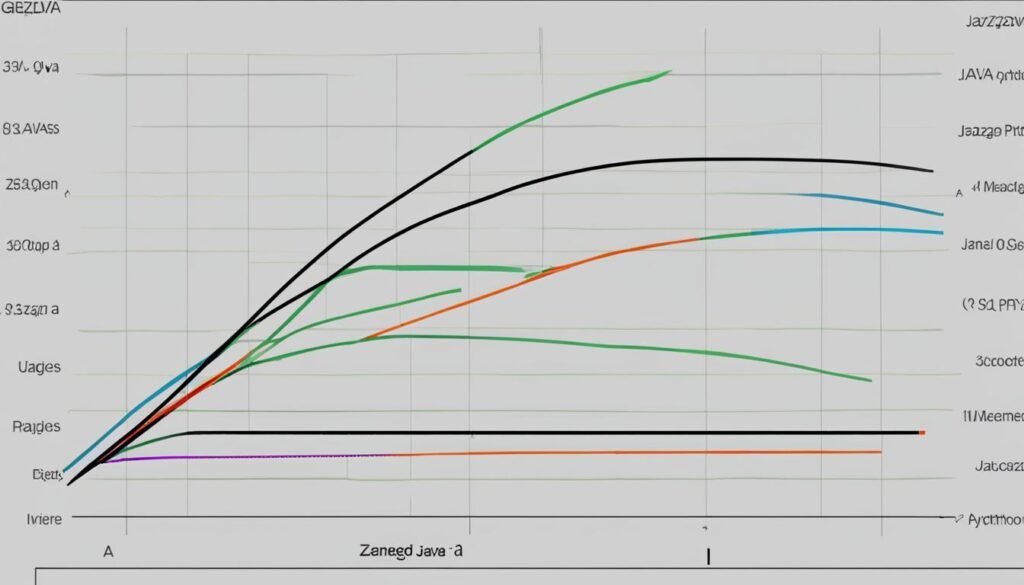When it comes to software development and programming languages, Python and Java are two popular choices among beginners and experienced engineers. While both languages offer powerful cross-platform support and extensive libraries, they shine in different applications. In this article, we will compare Python and Java in terms of popularity, syntax, applications, stability, speed, performance, and easiness to learn. By understanding their key differences, you can make informed decisions when it comes to coding basics and scripting skills.
Key Takeaways:
- Python and Java are both popular programming languages for software development.
- Python is known for its simplicity and ease of use, making it a popular choice for beginners.
- Java offers speed, stability, and extensive support for enterprise-level applications.
- Python is commonly used in data science, machine learning, and web development.
- Java is widely used in enterprise applications, web development, mobile development, and gaming.
Introduction to Python
Python is a widely used programming language that was first introduced in 1991 by Guido van Rossum. It gained popularity due to its simplicity, readability, and versatility. Python is an interpreted language, meaning that it does not require compilation before execution. This makes it easy to write and test code quickly without the need for complex setup.
One of the key features of Python is its dynamic typing. Unlike statically typed languages like Java, Python allows you to assign values to variables without explicitly defining their data type. This makes Python code more concise and flexible, especially for beginners who may find static typing intimidating.
“Python is known for its simplicity and ease of use, making it popular among beginners and compared to other programming languages like Perl, Ruby, and Java.”
Python has gained immense popularity in various domains, including web development, data science, machine learning, scientific computing, and automation. It has a vast collection of libraries and frameworks that simplify complex tasks and enable developers to build powerful applications with minimal effort.
Python’s versatility and beginner-friendly nature make it an ideal choice for those starting their programming journey. Its readability and extensive community support make it easier to learn and collaborate with other developers. Whether you are a beginner or an experienced programmer, Python offers a solid foundation for building software solutions.
Python Logo
Introduction to Java

Java is a widely used programming language known for its versatility and robustness. Developed by James Gosling at Sun Microsystems in 1995, Java has become a go-to choice for many developers due to its wide range of applications and platform independence. As a compiled language, Java offers high performance and stability, making it well-suited for complex enterprise-level applications.
One of the key features of Java is its static typing system. This means that variables must be declared with a specific data type before they can be used, providing better code reliability and preventing certain types of errors. Java’s static typing also allows for strong type checking during compilation, ensuring that potential issues are caught early in the development process.
Java’s syntax is influenced by C++ and C, but it offers higher-level facilities and a more streamlined approach to programming. With its rich set of libraries and frameworks, Java is widely used in various domains such as web development, mobile development, and gaming. Its platform independence allows developers to write code once and run it on any machine, making Java a popular choice for building cross-platform applications.
Benefits of Java:
- Robust and reliable, suitable for large-scale applications
- Platform independence allows code to run on any machine
- Extensive libraries and frameworks for rapid development
- Strong typing system for better code reliability
- Support for multithreading and concurrency
Java is a powerful programming language that offers a wide range of benefits for developers. Its stability, performance, and platform independence make it a popular choice for building enterprise-level applications. With a strong and supportive community, Java continues to evolve and remain relevant in the ever-changing landscape of software development.
Popularity and Applications of Python and Java

Python and Java are two of the most popular programming languages in the world, each with its own unique strengths and applications. According to Stack Overflow and GitHub Octoverse, Python has gained a slight advantage over Java in terms of popularity. Python’s rise in popularity can be attributed to its versatility and ease of use, making it a popular choice for beginners and experienced developers alike.
Python is widely used in various domains, including data science, machine learning, and scientific computing. Its extensive libraries and frameworks, such as NumPy, Pandas, and TensorFlow, make it a preferred language for implementing complex algorithms and performing data analysis. Additionally, Python’s simplicity and readability make it an ideal choice for web development and scripting tasks.
On the other hand, Java is widely used in enterprise applications, web development, mobile development, and gaming. Its robustness, scalability, and platform independence make it an excellent choice for building large-scale applications. Java’s extensive ecosystem and frameworks, such as Spring and Hibernate, provide developers with the tools they need to create powerful and reliable software solutions.
Python Applications:
- Data science and machine learning
- Web development
- Scientific computing
Java Applications:
- Enterprise applications
- Web development
- Mobile development
- Gaming
Both Python and Java have their own unique uses and strengths, and the choice between them ultimately depends on the specific requirements of the project. Python’s popularity in machine learning and data science makes it a top choice for those fields, while Java’s stability and scalability make it the preferred language for enterprise-level applications. Understanding the applications and popularity of both languages is crucial for developers when deciding which language to pursue.
Syntax and Performance Comparison

Python and Java, two of the most popular programming languages, have distinct differences in syntax and performance. These differences play a crucial role in determining which language is better suited for specific applications and developer preferences.
Syntax:
Python’s syntax is known for its simplicity and conciseness. With a focus on readability, Python code is easier to understand and write. The use of indentation to define blocks of code enhances code readability and reduces the need for excessive punctuation.
“Python syntax is like writing English, it’s so clean and easy to read. It really makes coding a breeze!” – Python developer
In contrast, Java has a more verbose syntax compared to Python. Java requires the explicit declaration of data types and the use of semicolons to terminate statements. This makes Java code more structured but also increases the amount of code needed to accomplish the same task.
“Java’s syntax can be a bit overwhelming at first, but once you get used to it, it provides a strong foundation for building robust applications.” – Java developer
Performance:
When it comes to performance, Python is an interpreted language, meaning it is executed line-by-line during runtime. While this provides flexibility and ease of development, it can result in slower execution speed compared to Java.
Java, on the other hand, is a compiled language. It undergoes a compilation process before execution, allowing for faster execution and optimized performance. The static typing in Java also helps catch errors during compilation, which can enhance overall performance.
In conclusion, Python’s concise and intuitive syntax makes it a popular choice for beginners and developers who prioritize code readability and ease of use. Java, with its more structured syntax and compiled nature, offers better performance and is often used for building robust enterprise applications. Understanding the differences in syntax and performance is crucial in selecting the right language for your specific programming needs.
Stability, Speed, and Learning Curve

When comparing Python and Java, it’s important to consider factors such as stability, speed, and the learning curve associated with each language. Python, being an interpreted language, tests syntax during runtime, which can result in less stability compared to Java. On the other hand, Java checks syntax during compilation, making it more stable and less prone to errors.
Speed is another aspect to consider. Python, known for its rapid development and simplicity, allows for faster coding. However, Java projects tend to take longer and often require larger development teams due to its more rigorous syntax and extensive enterprise-level features.
As for the learning curve, Python is commonly regarded as an easier language to learn, making it a popular choice for beginners. Its intuitive syntax and straightforward programming concepts provide a smooth entry into the world of coding. Java, on the other hand, has a steeper learning curve due to its stricter syntax and complex features. However, it offers developers more control and is well-suited for building robust enterprise-level applications.
Key Points:
- Python’s runtime syntax testing makes it less stable compared to Java’s compilation-based syntax checking.
- Python allows for faster coding due to its simplicity, while Java projects tend to take longer and require larger development teams.
- Python is considered easier to learn due to its intuitive syntax, making it a popular choice for beginners, while Java has a steeper learning curve but offers more control for complex applications.
Conclusion
When it comes to choosing between Python and Java, it ultimately depends on your specific needs and goals in the coding journey. Both programming languages have their own strengths and applications in the software development field.
Python is highly favored for its simplicity, versatility, and popularity in the domains of data science and machine learning. With its intuitive syntax and extensive libraries, it is a great choice for beginners who want to dive into the world of programming languages.
On the other hand, Java is known for its speed, stability, and extensive support for enterprise-level applications. While it may have a steeper learning curve, it offers more control and is suitable for complex projects that require a larger development team.
Whether you are a beginner or an experienced programmer, understanding the key differences between Python and Java will help you make informed decisions on your coding journey. Both languages have their place in the software development landscape, so it’s important to evaluate your specific requirements and choose the one that aligns best with your goals.
FAQ
What are the key differences between Python and Java?
Python and Java differ in terms of syntax, performance, stability, and applications. Python has a more concise syntax, while Java has a more verbose syntax. Python is an interpreted language, while Java is compiled. Java offers better performance due to its static typing and ahead-of-time compilation. Java is commonly used in enterprise applications, web development, mobile development, and gaming, while Python is popular in data science, machine learning, scientific computing, and web development.
Which programming language is easier to learn, Python or Java?
Python is considered easier to learn compared to Java. Python has an intuitive and readable syntax, making it a popular choice for beginners. Java, on the other hand, has a steeper learning curve but offers more control and is suitable for complex enterprise-level applications.
What are the popular applications of Python?
Python is commonly used in data science, machine learning, scientific computing, and web development. Its simplicity, versatility, and extensive libraries make it a popular choice in these fields.
What are the popular applications of Java?
Java is widely used in enterprise applications, web development, mobile development, and gaming. Its platform independence, speed, and extensive support for enterprise-level applications make it a preferred choice in these areas.
Which programming language is more stable, Python or Java?
Java is generally considered more stable compared to Python. Java checks syntax during compilation, resulting in higher stability. Python, on the other hand, tests syntax during runtime.
Which programming language is faster, Python or Java?
Java is generally faster than Python. Java’s static typing and ahead-of-time compilation allow for faster execution. Python’s rapid development and simplicity make it faster for writing code, but Java projects tend to take longer and require larger development teams.
Which programming language should I choose, Python or Java?
The choice between Python and Java depends on your specific needs and goals. Python is favored for its simplicity, versatility, and popularity in fields like data science and machine learning. Java is known for its speed, stability, and extensive support for enterprise applications. Consider your project requirements, complexity, and personal preferences before making a decision.
Source Links
- https://www.imaginarycloud.com/blog/python-vs-java/
- https://raygun.com/blog/java-vs-python/
- https://www.coursera.org/articles/python-vs-java


